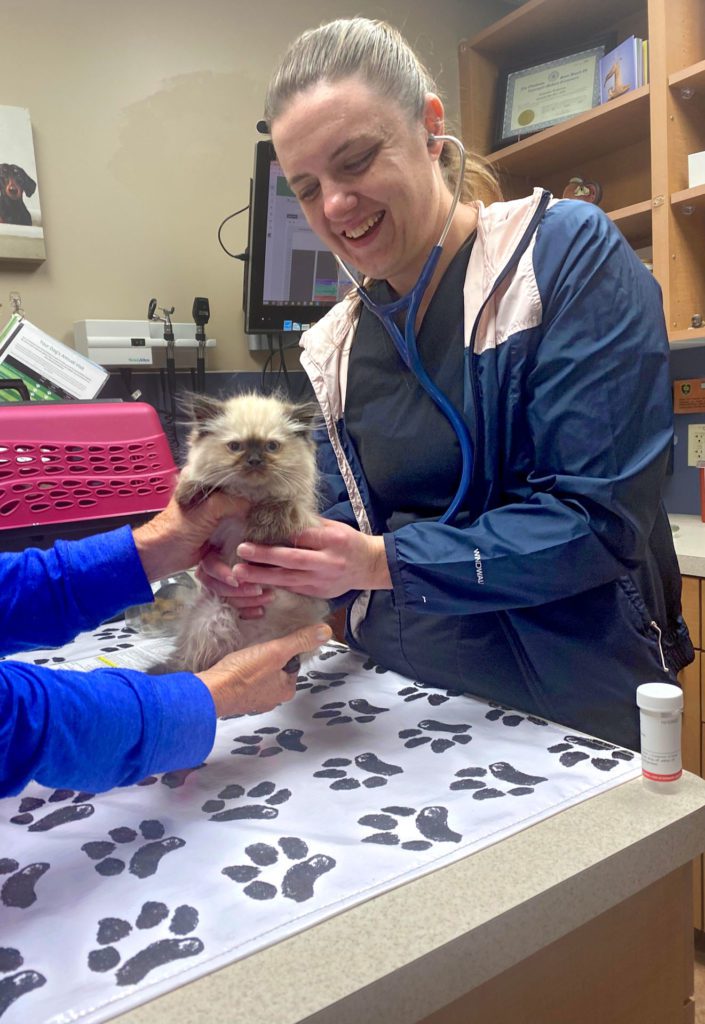Popular Breeds
“The most prevalent dog breeds now are, in my experience, the Pitbull/Pit mix dogs,” says Mark Appelbaum, DVM, of Tulsa’s Appelbaum Animal Clinic. “We see a large number, and most are very sweet. Another breed that seems to get adopted a lot are Boxer mixes. Lab amd Lab mixes are also a common rescue/adopted dog.
“One of the most popular dogs being purchased is the Doodle breed. There are now many types of Doodles, including Labra-Doodles, Golden-Doodles, Aussie-Doodles and Bernie-Doodles.”
When it comes to breeds that stay consistently popular over time, Appelbaum points toward Labrador Retrievers, Golden Retrievers and Pit/Bull Terriers.
“However, we do see a lot of Terrier type dogs as well,” he says. “Yorkshire Terriers are a popular breed for people to buy. The trendy dogs are the Doodles, of course, as well as Morkie – a mix of Maltese and Yorkie. I’ve been at this long enough to remember the trendy ones in the past, including the Schnoodle – a Schnauzer and Poodle mix; the Cockapoo, a Cocker and Poodle mix; and the Pekapoo, a mix of Pekingese and Poodle.”
Body Language 101
Since dogs and cats can’t use words to communicate, they rely on body language to give you the signs – through ears, eyes, tail and posture.
“Some general indications that a dog is stressed include panting when not hot, lip licking when not eating, yawning, pacing and moving away,” says Anna Woolley, DVM, with Tulsa’s Woodland West Animal Clinic. “Many of us are used to looking at a wagging tail as a happy or friendly dog. While a gentle wag in a moderate position suggests a dog is willing to interact, a stiff wagging tail held high suggests arousal or aggression. A tucked tail suggests fear, and this dog, as well as the dog with the stiff tail, need their space.”
The presence or absence of eye contact is also telling, she says.
“A direct gaze suggests a dog is willing to interact, but if the gaze is tense with tight lips and eyelids pulled back, this dog needs to be avoided,” she says. “A slightly averted gaze, or one where the white of the eyes are seen, may convey submission or fear.”
When it comes to the ears, “relaxed, alert ears with relaxed eyes usually indicate a dog is willing to interact,” she says. “Tense, alert ears with tight lips and a harsh gaze conveys arousal or aggression. Ears softly pulled back indicate a submissive or non-threatening posture.”
Cat body language, however, is a bit more difficult to read, says Woolley.
“A soft tail movement usually conveys a content cat, while a flicking tail means the cat is unhappy,” she says. “The overall relaxed or tense appearance in eyes and ears are similar to the dog, except much more subtle. Cats can escalate from apparent relaxation to fear and aggression very quickly.”
Spotting the Signs
When it comes to common health issues with animals, knowing some potential warning signs can make all the difference.
External parasites, like fleas and ticks, and internal parasites, like hookworms, roundworms, whipworms and tapeworms, plus ear infections, are all common with animals, says Todd Yeagley, DVM, also with Woodland West Animal Hospital.
Some general behaviors to watch out for, he says, include excessive vomiting, scooting, itching/scratching continuously, significant hair loss, and rubbing the ears and face across surfaces.
“Luckily, we are living in a time where we have excellent preventative choices that can prevent disease or issues caused by these parasites,” he says.
When it comes to masses on the skin, Yeagley says it’s “difficult to tell whether a skin mass is benign or malignant based upon appearance or feel. It’s best to have the mass assessed by a veterinarian.”
Urinary tract infections are common in female dogs, says Yeagley, and rarer in cats. Dogs with UTIs generally urinate small, frequent amounts as compared to their normal habits.
Periodontal disease is pervasive in dogs and cats. Look for decreased appetite or hesitance to eat/drink, excessive drooling, and swelling below eyes and along the cheekbones. Yearly dental cleanings and exams, as well as daily dental chews, can help to slow the progression of dental disease. Bloodwork screenings can also detect many problems early before they cause significant harm.
The Details on Separation Anxiety
Many pets prefer not to be left alone, and some get into mischief by chewing up belongings, vocalizing and greeting owners exuberantly upon their return. True separation anxiety, however, is a disorder resulting in overstimulation of the nervous system, says Woolley.
“Dogs with separation anxiety can develop gastrointestinal upset, racing heart and respiratory rates, muscular over-activity and dilated pupils. Most of these dogs will vocalize and/or pace for hours at a time, often salivating excessively. These dogs are not being ‘bad’; they have no control over these responses,” she says.
But where does separation anxiety stem from?
“It occurs, not infrequently, in dogs that have been rehomed,” she says. “It was thought for years that dogs ‘hyper-attached’ to an owner were more prone to separation anxiety, but that is not true in most cases. The role of COVID-19 in the incidence of this disorder has not been fully studied yet, but it is likely that dogs exhibiting separation anxiety when their owners return to work likely had some anxiety to start with. These dogs, especially dogs adopted during pandemic isolation, have had little practice getting used to their owner’s absence.”
Because anxiety disorders are a medical problem, most cases of true separation anxiety require medication as well as behavior modification.
Why Spay/Neuter?
It’s no secret that spaying or neutering your animal has ample benefits. These include the avoidance of euthanasia of stray animals due to population issues, as well as helping with the continual overcrowding in shelters. The behavioral benefits associated with spaying/neutering are a reduction in roaming, mounting and urine marking, mostly in male dogs.
“Like I tell owners – they like to do what teenage boys want to do,” says Appelbaum, “which is look for girls, look for fights and chase cars.”
But aside from these benefits, spaying/neutering could save your animal’s life.
“From a medical standpoint, when dogs aren’t spayed or neutered at a younger age, it can lead to health issues later in life,” he says. “For females, the more heat cycles they go through increases the chance of mammary cancers later in life. We also see life-threatening uterus infections.”
When it comes to timing, “we recommend neutering dogs at a younger age,” says Appelbaum. “Some people like to wait until larger dogs are more skeletally mature – around a year or so, which is fine. The health risks of not neutering younger are present as well, though. We see prostate enlargements, chronic urinary tract infections and testicular tumors in intact male dogs.”
Pet DNA Tests
Guessing a dog’s breed based just on appearance has an accuracy of around 25%, so DNA test results can be a huge surprise to an owner, says Woolley.
Breed DNA tests can be quite accurate, in the range of 95-99% accuracy, she supplies. The quality of the report will depend on the sample obtained by the owner, as well as the company who runs the test. It is important that an owner follow the directions on the sampling device, as well as choose a company that tests a large number of genetic markers.
The Downsides of ‘People Food’
Think it’s OK to feed your pet people food? Think again. Many veterinarians advise not sharing that morsel of meat with your animal companion, and instead focus on foods formulated for their health and well-being.
“Cats and dogs do best with a stable, consistent diet,” says Yeagley. “It seems boring to us, but variances to their diet can cause gastrointestinal upset. We see it frequently. Sometimes, people food can cause the pancreas to become inflamed, which can manifest as a mild stomach ache, or it can be deadly. Most cases are somewhere in between and require veterinary treatment.”
Emotional Support Animals vs. Service Animals
According to the Americans with Disabilities Act, there is no major service animal versus emotional support animal difference. The ADA recognizes both as legitimate assistance for those with disabilities. However, a service animal is trained to perform tasks that assist people with disabilities or handicaps, and an emotional support animal does not require training at all.
“Both emotional support and service dogs need a physician prescription,” says Woolley. “An emotional support dog is permitted access to housing designated ‘no pets.’ Only service dogs are legally permitted access to restaurants and airplanes.”
Things to Avoid Bringing in the House
“The most common household toxins we see are marijuana, grapes, rodenticides, prescription medications and chocolate,” says Yeagley. “If you believe your pet has ingested a toxin, the best thing to do is contact your local veterinarian or ASPCA Poison Control.”






























